As any birdwatcher will tell you, male and female birds typically look distinct from each other, with males sporting bolder, more eye-catching plumage. Consider the white-necked Jacobin, a tropical hummingbird that spends its days flitting from flower to flower in the woodlands of South and Central America. Male Jacobins are instantly recognizable by their dazzling, iridescent feathers. Females’ feathers, in comparison, look washed-out and drab.
Except when they don’t. A recent study by Columbia ecologist Dustin R. Rubenstein, Jay J. Falk of the University of Washington, and Michael S. Webster of Cornell has revealed that approximately one in every six birds that appear to be adult male Jacobins is actually a female in disguise. The research team, which has been closely monitoring Jacobins in Panama since 2015, also discovered why these females evolved to resemble males.
“We’ve observed that the females with male-like plumage enjoy better access to food, because other birds, knowing that males are generally aggressive, will cede more space to them,” says Rubenstein, a professor of ecology, evolution, and environmental biology and the director of the Center for Integrative Animal Behavior. “Females with drab feathers, on the other hand, often get harassed and chased away from food sources.”
Rubenstein’s study, which appears in the journal Current Biology, adds to a growing body of research showing that female birds and animals can advertise their physical fitness or social status with conspicuous characteristics known as “biological ornaments.” Biological ornaments such as brightly colored feathers, bushy tails, and big horns are more commonly associated with male animals, which use them to attract mates. But Rubenstein says that females of many species of birds, fish, and insects have in recent years been found to use ornamentation to intimidate rivals when competing for nesting sites, food, and other resources needed to raise their young.
“This is still a relatively new area of research, because for a long time, scientists who were interested in ornamentation focused on male–male competition over access to females and how that process of ‘sexual selection’ influenced the evolution of male bodies,” Rubenstein says. “But females are obviously engaged in a lot of competitive activities that drive their evolution too.”
He hopes that further research on white-necked Jacobins will reveal the genetic basis for the masquerading females’ plumage and whether their flashy feathers are an indication of other male-like attributes the birds might possess.
“We’d like to know if these birds are actually stronger or more aggressive than ordinary-looking females,” Rubenstein says. “So far, our observations don’t bear that out. It seems that they’re just tricking other birds into thinking they’re tougher.”



